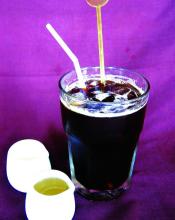The handling of coffee beans A coffee shop open all night in Changchun
Water Wash---Increases Fruit Acid sprite:
Water washing is currently the most popular treatment method, and water washing is almost all used in Central and South America except Brazil. The color of washed beans is blue-green and beautiful, the appearance of beans is neat and the pulse is good, and the coffee quality is the highest. Generally speaking, the acid flavor and bright feeling of washed beans are better, the flavor is clean and no miscellaneous taste, which is the most customary treatment method for fine coffee, and the price is not small. On average, washing 1 kg of coffee fruit requires 2-10 liters of clean water, while 1 kg of coffee fruit can only take about 200 grams of coffee beans. It is difficult for water-deficient areas to withstand such water-consuming bean extraction methods.
Washing is the most technical of all bean extraction methods. After multiple screening procedures, the quality of coffee is ensured. Red fruits and half-green and half-red fruits sunk in the tank are first transferred to large or medium-sized pulp sifting machines. It is cleverly designed to press the fruit mechanically against a sieve hole, size just to let the pods (i.e., coffee beans wrapped in sheepskin) pass through and sift out the pulp outside the pods--taking advantage of the hardness of the unripe fruit. Pods are not easy to squeeze out, while ripe fruits are soft, and pods are easily squeezed out to block immature beans and filter out the sweetest pods. Therefore, the setting of machine thrust is very important. Too much force will squeeze out the hard and astringent immature beans, which will damage the quality of fine beans. The normal pushing force is set to allow 3% of the red fruit pods to be squeezed out of the sieve holes, ensuring that all hard green fruits are rejected.
The sticky pods of the red fruit are removed and transferred to large tanks, where the most important fermentation process is washing to remove pectin from the pods. This viscous substance is not easy to wash away with water, so it needs to be hydrolyzed by various bacteria in the tank to decompose pectin into pectic acid, and continuously stir and rub and wash the pods in the tank to accelerate the pectin separation from the pods. The fermentation process takes about 16 to 36 hours, depending on temperature and humidity, at which point malic acid is naturally produced in the tank. Citric acid. Acetic acid. Lactic acid and propionic acid. Interestingly, raw beans themselves contain almost no acetic acid, but the fermentation process of washing can increase the acetic acid concentration of beans, which is beneficial to coffee flavor. These acidic substances can not only inhibit mold parasitism, but also part of the acid fragrance will be mixed into the beans (this is why the washed bean acid taste is heavier). However, samples must be taken at any time to see if the viscous pectin on the pod is removed, and then decide whether to stop fermentation and remove the clean pod. Once more than 36- 72 hours, it may be over-fermented, producing too much fatty acid and butyric acid (butyric acid) and emitting a foul smell, and beans mixed with too much acid will also make coffee too sour, Yu for poor beans!

Important Notice :
前街咖啡 FrontStreet Coffee has moved to new addredd:
FrontStreet Coffee Address: 315,Donghua East Road,GuangZhou
Tel:020 38364473
- Prev

Introduction to the Development Prospect of Coffee in Tanzania
Gourmet coffee has soft acidity and attractive aroma, which is absolutely worth enjoying. Coffee exports from Tanzania (Tanzania) play an important role in the whole national economy. Bean-shaped berry coffee is very productive and is said to be more fragrant than ordinary coffee. Generally speaking, the coffee beans in Tanzania have an extraordinary quality. For example, in the neighborhood of Kilimanja
- Next

Introduction of origin and producing areas of Guatemalan coffee beans
Dima is bordered by Mexico to the north, Honduras and El Salvador to the south, the Caribbean to the east and the Pacific Ocean to the west, with tropical rain forests, volcanic geology, plateau valleys and changeable microclimate. Guatemalan coffee once enjoyed the reputation of the best quality coffee in the world. The extra hard coffee beans here are full-grained, delicious and balanced, and the coffee made with it is pure and full-bodied.
Related
- Does Rose Summer choose Blue, Green or Red? Detailed explanation of Rose Summer Coffee plots and Classification in Panamanian Jade Manor
- What is the difference between the origin, producing area, processing plant, cooperative and manor of coffee beans?
- How fine does the espresso powder fit? how to grind the espresso?
- Sca coffee roasting degree color card coffee roasting degree 8 roasting color values what do you mean?
- The practice of lattes: how to make lattes at home
- Introduction to Indonesian Fine Coffee beans-- Java Coffee producing area of Indonesian Arabica Coffee
- How much will the flavor of light and medium roasted rose summer be expressed? What baking level is rose summer suitable for?
- Introduction to the characteristics of washing, sun-drying or wet-planing coffee commonly used in Mantenin, Indonesia
- Price characteristics of Arabica Coffee Bean Starbucks introduction to Manning Coffee Bean Taste producing area Variety Manor
- What is the authentic Yega flavor? What are the flavor characteristics of the really excellent Yejasuffi coffee beans?

